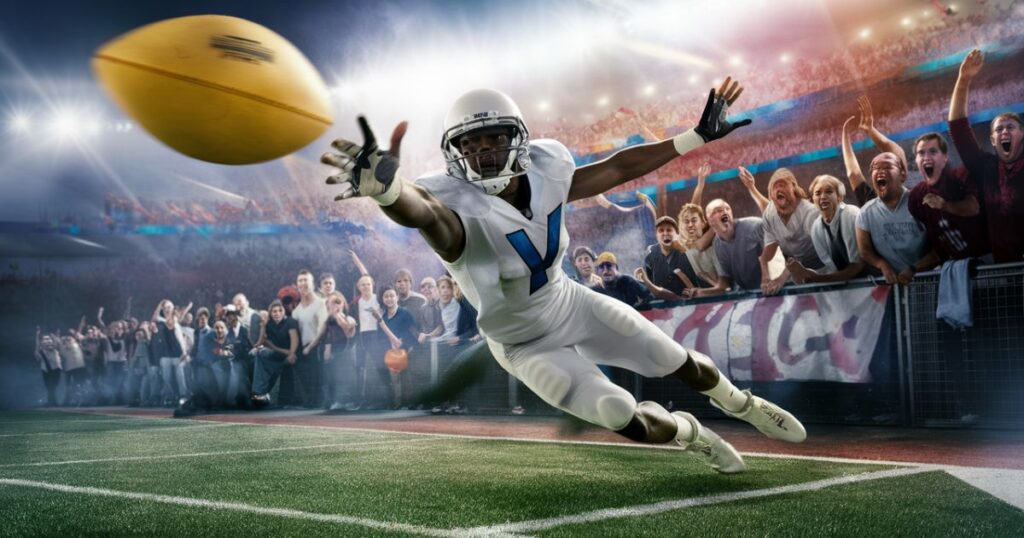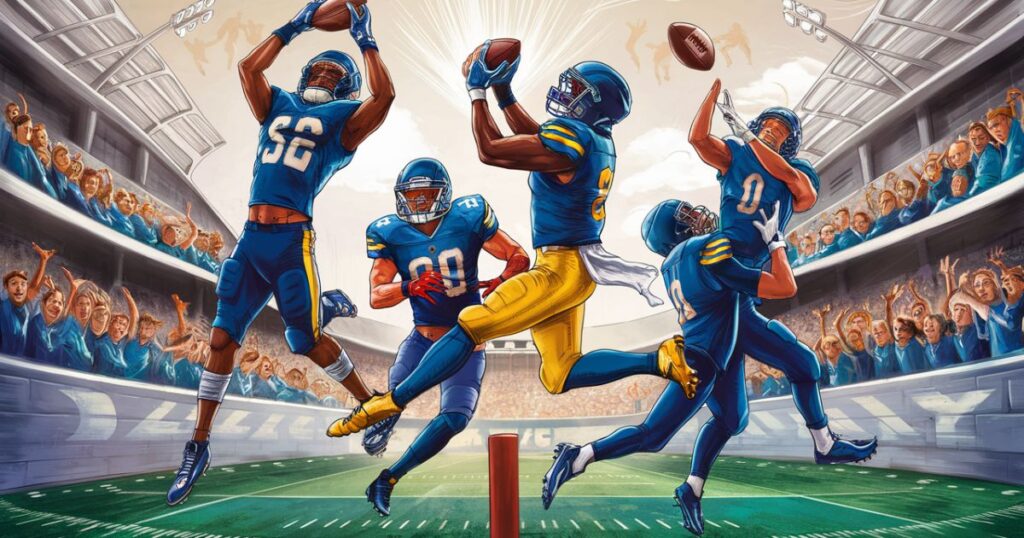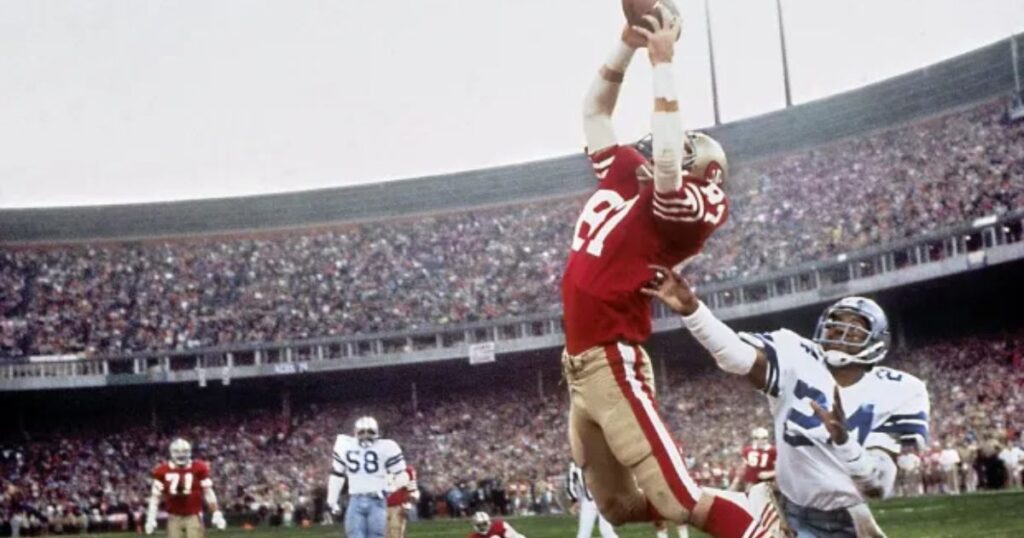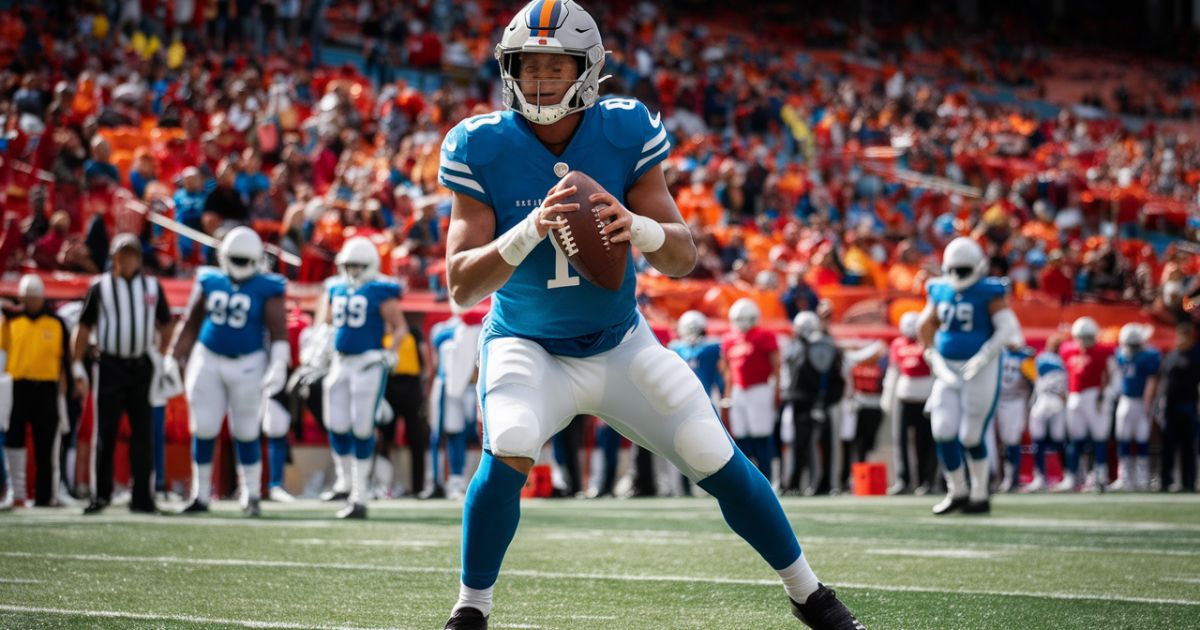A reception in football occurs when a forward pass thrown by the quarterback is caught by an eligible offensive receiver. It is a crucial play that allows the offense to advance the ball down the field.
For a reception to be legal, the receiver must secure full control of the ball with their hands or arms before the ball touches the ground. The receiver must get at least one foot or another body part down in bounds while maintaining possession.
What is a Reception in Football?
In the fast-paced world of American football, a reception is a fundamental play that can make or break a team’s offensive drive. At its core, a reception is when a player, typically a wide receiver or tight end, successfully catches a forward pass thrown by the quarterback.
This seemingly simple act is a intricate dance of skill, strategy, and split-second decision-making. A receiver must not only possess physical attributes like speed, agility, and leaping ability, but also a deep understanding of route concepts, defensive coverages, and timing patterns.
Catching the ball is just the beginning – the receiver must maintain control throughout the process, often while being hit by defenders, and ensure they are in bounds for the reception to be deemed complete.
The Role of the Receiver in Football

Wide receivers and tight ends are the primary targets for the quarterback’s passes, each serving a distinct yet crucial role in the offensive game plan:
- Wide Receivers: Known for their blazing speed and route-running prowess, wide receivers are tasked with stretching the field vertically and creating separation from defensive backs. Their ability to make contested catches and pick up yards after the catch (YAC) can swing momentum in an instant.
- Tight Ends: While still viable receiving threats, tight ends are valued for their versatility as both receivers and blockers. They often run shorter routes over the middle of the field, acting as a security blanket for the quarterback while also helping to protect against the pass rush.
Elite receivers possess an elusive blend of physical tools and mental acuity, allowing them to read defenses on the fly, adjust routes accordingly, and make the difficult catch look routine.
Read More : How Long Is A Soccer Game? Understanding The Duration Of Soccer Matches
Quarterback to Receiver: The Dynamics of a Successful Pass
While the receiver is the one making the catch, the quarterback is the maestro orchestrating the entire symphony. Delivering an accurate, well-timed pass requires:
- Reading the Defense: The quarterback must quickly diagnose the defensive coverage and identify which receiver has the best chance of getting open.
- Anticipation and Timing: Elite quarterbacks throw to a spot before the receiver even makes their break, trusting their pass will arrive perfectly in stride. This split-second choreography is the result of countless practice reps and an almost telepathic connection between passer and target.
- Arm Strength and Accuracy: Whether it’s a bullet pass through a tight window or a deep bomb down the sideline, the quarterback must have the physical tools to put the ball where only their receiver can make a play.
- Decision-Making Under Pressure: With defensive linemen bearing down, the quarterback must remain calm, go through their progressions, and deliver a strike. This mental toughness is what separates the great ones from the rest.
The synergy between a quarterback and their receiving corps is a beautiful, intricate symphony that takes years to fully develop and master. When it clicks, it’s poetry in motion.
Types of Receptions: From Short Passes to Downfield Thrillers

Not all receptions are created equal. They can range from simple dump-offs and check-downs to electrifying downfield strikes that send the crowd into a frenzy. Some common types include:
- Screen Passes: Short passes to a running back or receiver behind the line of scrimmage, designed to let them make a defender miss and pick up easy yards.
- Slants and In-Routes: Shorter patterns where the receiver cuts sharply across the middle of the field, often used to move the chains or exploit holes in zone coverage.
- Comeback Routes: The receiver first runs a vertical stem before breaking back towards the quarterback, creating separation from the defensive back.
- Deep Shots and Go Routes: Maximum protection shots downfield, where the receiver must track the ball over their shoulder and make a leaping grab for a huge gain.
The choice of passing concept depends on numerous factors: down and distance, personnel mismatches, defensive looks, and more. Offensive coordinators carefully script plays to put their playmakers in a position to succeed.
The Rules Surrounding Receptions: What Counts and What Doesn’t?
With so much riding on each reception, it’s no surprise that the rules governing a legal catch are strictly defined:
- Control of the Ball: The receiver must secure full possession and control of the ball throughout the entire process of the catch.
- Getting Two Feet Down: The receiver must get both feet (or another body part) down in bounds with control before going out of bounds.
- Completing the Process: Even if initially ruled a catch, if the ball comes loose after the receiver hits the ground, it is deemed an incomplete pass.
While these guidelines seem straightforward, there are countless examples of controversial “catch/no-catch” rulings that have sparked endless debate. Replay review has helped clarify some of these situations, but the”process of a catch” will forever be a gray area open to interpretation.
To illustrate, here are a few examples of legal and illegal receptions:
Legal Reception Examples:
- Receiver secures ball with both feet in bounds before falling out of bounds
- Tight end catches pass, gets hit immediately but maintains control when hitting the ground
- Wide receiver leaps, possesses ball with one hand extended over the sideline
Illegal Reception Examples:
- Ball moves and comes loose after receiver hits the ground
- Receiver catches ball but is pushed out before getting second foot down
- Pass is trapped against the ground without full control being established
Receptions in Different Football Leagues: Are There Variations?
While the fundamentals of a reception are universal across football leagues, there can be some nuanced rule differences and points of emphasis:
- NFL vs College: The NFL has a more stringent definition of a catch, with scrutiny on establishing full control and completing the process to the ground. College rules are more receiver-friendly.
- High School vs Pro: Catch rules are generally simplified at lower levels, with more leniency given if clear possession is established before going to the ground.
- International Leagues: With American football growing globally, leagues worldwide use slight variations of the NFL rulebook for receptions.
These inconsistencies reflect the subjective nature of rulings and philosophies around what constitutes an accurate representation of a catch. As the game evolves, strides towards universal standards may emerge.
Famous Reception Plays in Football History

Certain receptions have etched their way into football immortality, with their images and drama forever ingrained in a fan’s memory:
The Catch (1981 NFC Championship)
- Joe Montana’s desperation heave finding Dwight Clark leaping in the back of the end zone to propel the 49ers to their first Super Bowl.
The Immaculate Reception (1972 Divisional Playoffs)
- Terry Bradshaw’s deflected pass being scooped out of the air by Franco Harris, setting up the game-winning score for the Steelers in what’s considered one of the greatest plays ever.
The Helmet Catch (Super Bowl XLII)
- Eli Manning’s miraculous escape and launch downfield, which David Tyree pinned against his helmet for a game-extending grab, leading to the Giants’ huge Super Bowl upset over the Patriots.
These are just a few examples of receptions that will be replayed and discussed for generations – true testament to the dramatic weight and skill required to make the improbable catch.
Techniques and Drills
Becoming an elite receiver is a never-ending process of honing one’s skills through detailed technique work and repetition. Some drills receivers utilize:
- Hands Drills: Working on hand positioning, concentration catches, plucking the ball away from the body to develop a “catch radius.”
- Route Running: Mastering the footwork, stem, and timing for every route concept through intense positional drilling.
- Agility Work: Constant ladder drills, cone drills, and change-of-directionework to maintain explosiveness.
In addition, film study is paramount for receivers to recognize defensive tendencies and nuances in coverages. The best in the game are students of the game.
Analyzing Statistics: What Do They Tell Us?
Like any skilled position, a receiver’s performance and value are largely quantified through various statistical metrics:
- Receptions: The total number of catches made, indicating a receiver’s role and how frequently they are targeted.
- Receiving Yards: Yards gained after the catch, showing a receiver’s ability to produce chunk plays and stretch the field vertically.
- Touchdowns: Scoring plays are the ultimate measure of a receiver’s impact in the red zone and big-play ability.
Analytics go far beyond basic counting stats. Data points like catch rate, yards per route run, air yards, and more provide deeper context into a receiver’s efficiency, separation abilities, and overall role within the offensive scheme.
The Future of Receptions in Football: Evolving Strategies and Trends

As with any aspect of the game, the art of the reception is continuously evolving based on rule changes, coaching philosophies, and innovative techniques:
Rule Changes
- Potential adjustments to what constitutes a legal catch could drastically impact receiver play and situational strategy.
- Increased safety-oriented rules may alter how defenseless receivers can be defended.
Offensive Innovations
- The increased adoption of air raid/spread offenses emphasizes receiver play and creates more spacing/opportunities for receptions.
- Creative coaching minds are devising new route combinations and bunch concepts to create optimal passing windows.
Training Advancements
- Developments in sports science, nutrition, and strength/conditioning programs are allowing receivers to reach new levels of athleticism.
- Cutting-edge virtual reality and motion-capture technology provides novel ways to refine technique without live reps.
As coaches and players continue pushing the boundaries, the exciting future of receptions could feature even more highlight-reel grabs and new statistical benchmarks being set.
Conclusion – What is a Reception in Football?
A reception is far more than just catching a ball – it’s the culmination of physical talent, mental processing. And finely-tuned teamwork between multiple positions. Despite its simple definition, the reception is an integral part of football’s rich tapestry.
From the intricacies of getting both feet down to making the improbable circus catch look routine, receptions showcase the incredible skills possessed by the game’s elite pass-catchers. And the schemes and strategies surrounding them are a living embodiment of football’s ever-evolving complexities.
Whether it’s a catch that swings momentum in a crucial game or quietly moves the chains on a drive, receptions are woven into the very fabric of the sport. As the game progresses, the art of the reception will continue captivating fans with its drama and big-play excitement.
FAQs
What is behind the line of scrimmage?
The line of scrimmage marks the start of a new offensive play from scrimmage. All plays and player movement happen after they pass this line.
What does a running back do?
A running back is an offensive weapon who takes handoffs from the quarterback or catches passes out of the backfield, using speed and elusiveness to gain yards on the ground.
Is there a world cup in (American) football?
No, there is no true “World Cup” tournament for American football. The sport’s biggest event is the NFL’s Super Bowl to crown the league champion each year. International competition is still relatively uncommon.



